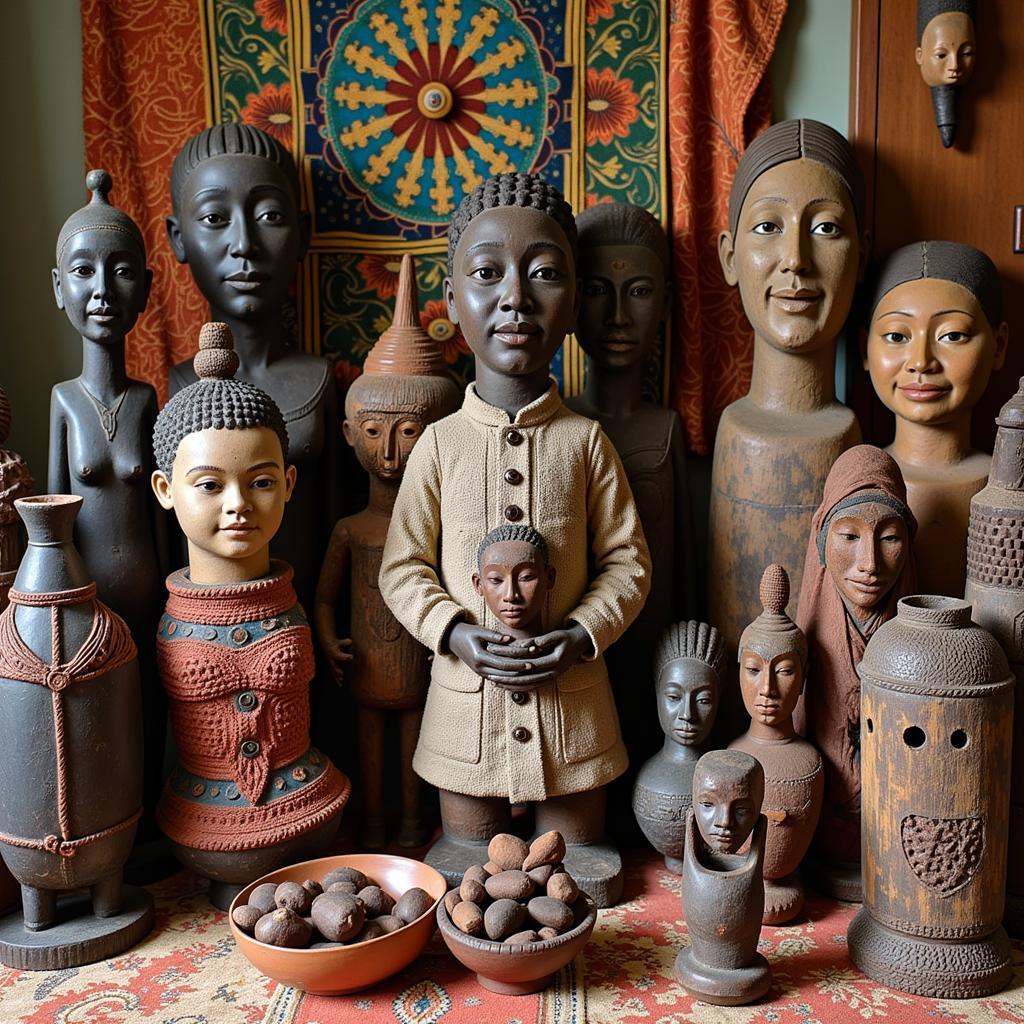African Art Items in Europe and Americas: A Complex Legacy
African Art Items In Europe And Americas represent a vast and complex history, encompassing centuries of cultural exchange, colonial exploitation, and ongoing repatriation efforts. From ancient sculptures to intricate masks and vibrant textiles, these objects tell powerful stories of creativity, spirituality, and resilience. This article explores the multifaceted presence of African art in Western collections, examining its historical context, cultural significance, and the ethical dilemmas surrounding its acquisition and ownership.
The presence of African art in Western museums and private collections raises important questions about cultural heritage, ownership, and the legacy of colonialism. How did these objects come to be in Europe and the Americas? What are the ethical implications of their acquisition and display? What efforts are being made to repatriate these cultural treasures to their countries of origin?
The Journey of African Art Items to Europe and Americas
The arrival of African art items in Europe and Americas can be traced back to several key historical periods. Early European explorers and traders brought back objects as curiosities, often misunderstanding their cultural significance. The transatlantic slave trade resulted in the forced displacement of millions of Africans, along with their artistic traditions and cultural objects. Later, during the colonial era, European powers systematically plundered African artifacts, viewing them as trophies of conquest and evidence of “primitive” cultures. These objects were often displayed in ethnographic museums, reinforcing colonial narratives and stereotypes.
Understanding the Cultural Significance
Beyond their aesthetic value, African art items hold profound cultural meaning. Masks, for example, are not simply decorative objects; they are often used in rituals and ceremonies, representing spirits, ancestors, or social roles. Sculptures can embody deities, historical figures, or abstract concepts. Textiles, with their intricate patterns and vibrant colors, often convey social status, clan affiliation, or spiritual beliefs. Understanding the cultural context of these objects is crucial to appreciating their true significance. They are not mere artifacts; they are living expressions of African history, spirituality, and cultural identity.
Many African governments are actively working to reclaim their cultural heritage, demanding the return of stolen artifacts from museums and private collections across Europe and Americas. These repatriation efforts are gaining momentum, fueled by a growing awareness of the injustices of the colonial past and the importance of cultural preservation. Organizations like Mnesty LLC advocate for the return of African art items and offer support to African governments in their repatriation claims. You can find more information about their work at african art items in europe and americas mnesty llc. This is a complex process involving legal and ethical considerations, as well as the practical challenges of identifying, authenticating, and transporting these valuable objects.
The Ethical Debates Surrounding Ownership and Repatriation
The presence of African art in Western collections has sparked intense ethical debates. Critics argue that these objects are the product of theft and exploitation, and their continued presence in Western museums constitutes a form of ongoing cultural dispossession. Others argue that these institutions play a valuable role in preserving and showcasing African art, making it accessible to a wider audience. The debate centers on questions of ownership, cultural patrimony, and the responsibility of museums to address the legacies of colonialism.
Where Do We Go From Here?
The future of African art items in Europe and Americas is uncertain. Repatriation efforts are gaining traction, but the process is slow and complex. Museums are increasingly grappling with their colonial past, exploring new ways to engage with African communities and tell more inclusive stories. The conversation about ownership, cultural heritage, and the ethical responsibilities of museums is ongoing, and it will shape the way we understand and appreciate African art in the years to come. Understanding how African governments function can further inform this dialogue, and you can explore related information at african government facts.
“The repatriation of African art is not just about returning objects,” says Dr. Kwame Asante, a renowned art historian specializing in African art. “It’s about restoring cultural identity, acknowledging historical injustices, and empowering African communities to control their own narratives.”
“Museums have a crucial role to play in this process,” adds Dr. Amina Diallo, an expert in museum studies and cultural heritage. “They need to move beyond simply displaying objects and actively engage in dialogue with African communities, working collaboratively to tell more complete and accurate stories about African art and history.”
Conclusion
African art items in Europe and Americas represent a complex and often painful history. From their initial acquisition through colonial exploitation to the ongoing repatriation debates, these objects raise fundamental questions about cultural heritage, ownership, and the legacy of colonialism. While the future of these objects remains uncertain, the conversations surrounding them are crucial to understanding and appreciating the rich and diverse artistic traditions of Africa. These discussions will ultimately shape the way we engage with African art in the 21st century.
FAQ
- What are some of the most common types of African art found in Western collections?
- How did the colonial era impact the acquisition of African art by European powers?
- What are the main arguments for and against the repatriation of African art?
- What role do museums play in the debate surrounding African art ownership?
- What are some examples of successful repatriation efforts?
- How can individuals support the repatriation of African art?
- What are the ethical considerations surrounding the display of African art in Western museums?
Need support? Contact us 24/7: Phone: +255768904061, Email: kaka.mag@gmail.com, Address: Mbarali DC Mawindi, Kangaga, Tanzania.


